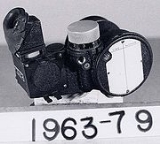
Earth Inductor Compass
Encyclopedia
The Earth inductor compass (or simply induction compass) is a compass
that determines directions using the principle of electromagnetic induction
, with the Earth's magnetic field
acting as the induction field for an electric generator. The electrical output of the generator will vary depending on its orientation with respect to the Earth's magnetic field. This variation in the generated voltage is measured, allowing the Earth inductor compass to determine direction.
at the Pioneer Instrument Company
in the United States. Designed to compensate for the weaknesses of the magnetic compass, the Earth inductor compass provided pilots with a more stable and reliable reference instrument. They were used in the Douglas DWCs during the 1924 U.S. Army Air Corps Around-the-World flight. Charles Lindbergh
used the compass on his transatlantic flight
in the Spirit of St. Louis
in 1927.
Compass
A compass is a navigational instrument that shows directions in a frame of reference that is stationary relative to the surface of the earth. The frame of reference defines the four cardinal directions – north, south, east, and west. Intermediate directions are also defined...
that determines directions using the principle of electromagnetic induction
Electromagnetic induction
Electromagnetic induction is the production of an electric current across a conductor moving through a magnetic field. It underlies the operation of generators, transformers, induction motors, electric motors, synchronous motors, and solenoids....
, with the Earth's magnetic field
Earth's magnetic field
Earth's magnetic field is the magnetic field that extends from the Earth's inner core to where it meets the solar wind, a stream of energetic particles emanating from the Sun...
acting as the induction field for an electric generator. The electrical output of the generator will vary depending on its orientation with respect to the Earth's magnetic field. This variation in the generated voltage is measured, allowing the Earth inductor compass to determine direction.
History
The earth inductor compass was invented in 1924 by Morris TitteringtonMorris Titterington
Morris Maxey Titterington was a pioneering aviator, and engineer.-Biography:Titterington was born in Paris, Texas, the son of George Titterington....
at the Pioneer Instrument Company
Pioneer Instrument Company
The Pioneer Instrument Company was started by Morris Titterington and Brice Herbert Goldsborough in Brooklyn, New York in 1919. Charles H. Colvin was the president. They specialized in aeronautical instruments including a bubble sextant and the Earth Inductor Compass...
in the United States. Designed to compensate for the weaknesses of the magnetic compass, the Earth inductor compass provided pilots with a more stable and reliable reference instrument. They were used in the Douglas DWCs during the 1924 U.S. Army Air Corps Around-the-World flight. Charles Lindbergh
Charles Lindbergh
Charles Augustus Lindbergh was an American aviator, author, inventor, explorer, and social activist.Lindbergh, a 25-year-old U.S...
used the compass on his transatlantic flight
Transatlantic flight
Transatlantic flight is the flight of an aircraft across the Atlantic Ocean. A transatlantic flight may proceed east-to-west, originating in Europe or Africa and terminating in North America or South America, or it may go in the reverse direction, west-to-east...
in the Spirit of St. Louis
Spirit of St. Louis
The Spirit of St. Louis is the custom-built, single engine, single-seat monoplane that was flown solo by Charles Lindbergh on May 20–21, 1927, on the first non-stop flight from New York to Paris for which Lindbergh won the $25,000 Orteig Prize.Lindbergh took off in the Spirit from Roosevelt...
in 1927.

